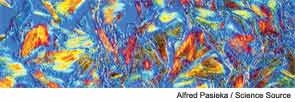
WASHINGTON, D.C.—A number of challenging and unresolved issues regarding hyperuriciemia were addressed during a session titled, “Gout and Hyperuricemia: Diseases Beyond the Joint,” here at the 2012 ACR/ARHP Annual Meeting, held November 9–14. These issues included the treatment of gout in patients with chronic kidney disease (CKD) as well as a discussion of the potential use of uric acid levels as a predictive marker of cardiovascular disease and incorporating that marker into the clinical assessment of patients at high risk for cardiovascular disease. [Editor’s Note: This session was recorded and is available via ACR SessionSelect at www.rheumatology.org.]
Gout Treatment in Patients with CKD
Although CKD is common in patients with gout and complicates gout management, effective treatment and preventive strategies are available. “For most patients, gout can be effectively managed even in the context of significant comorbid diseases that so often accompany gout,” said Ted R. Mikuls, MD, MSPH, professor of internal medicine in the division of rheumatology at the University of Nebraska Medical Center in Omaha.
However, he emphasized that successful treatment in these patients typically requires “very judicious dose adjustments of medications accompanied by patient education and appropriate surveillance.”
For example, Dr. Mikuls presented information on the appropriate use of allopurinol in this setting based on current data and guidelines. Although there has been some concern about the use of allopurinol in patients with CKD because of their increased risk for the development of allopurinol hypersensitivity syndrome (AHS), Dr. Mikuls emphasized that appropriate initial dosing followed by gradual titration of allopurinol likely mitigates this risk. He cited the 2012 ACR gout management guidelines on the use of allopurinol that emphasized a starting dose of 50 mg/day for patients with stage 4 or worse CKD (and no greater than 100 mg/day for any patient) and then titrating a maintenance dose every two to five weeks to appropriate maximum dose.1 The guidelines state that the dose can be raised above 300 mg a day even in patients with renal impairment if the patient receives education and monitoring for drug toxicity. For patients who are intolerant to allopurinol or at high risk of developing AHS, he said that febuxostat and pegloticase are good alternatives.
For the prevention of acute attacks that complicate the use of urate-lowering therapies, Dr. Mikuls said that colchicine is a good option but needs to be adjusted for renal function. For normal renal function to moderate CKD, he said the dose is 0.6 mg once daily or twice daily, and for severe CKD, the maximum dose is 0.3 mg daily, with dosing every two to three days. Overall, he said that the use of colchicine for prophylaxis requires vigilance because of the increased risk for myopathy, neuropathy, and cytopenias as well as important drug–drug interactions with such drugs as macrolides and statins.
Dr. Mikuls emphasized that effective treatment and prevention of gout requires attention. “I think gout is often thought of incorrectly as a one-visit encounter for providers, a mindset that we really need to get away from, particularly in our gout patients with chronic comorbid illnesses,” he said.
Hyperuricemia a Potential Marker
A growing body of evidence suggests a role for the use of hyperuricemia as a potential marker predictive of people at increased risk for cardiovascular disease, according to Eswar Krishnan, MD, assistant professor of medicine, in the division of immunology and rheumatology at Stanford School of Medicine in Stanford, Calif. Although a causal relationship between hyperuricemia and cardiovascular disease remains under debate, Dr. Krishnan said that even without established causality, the long recognized association between high uric acid and cardiovascular disease can provide clinicians with some useful information in assessing cardiovascular risk.
In his presentation, Dr. Krishnan suggested that testing uric acid levels in a patient with other risk factors for cardiovascular disease may be an easy and cost-effective way of further predicting which patients are truly at risk. Although he said the contribution may be only minor in helping to predict cardiovascular disease risk beyond the major contributions made by clinical history (e.g., age, sex, body mass index, hypertension and smoking status, and family history of heart attacks), and that a lipid profile would be the best test for predictability after clinical history, he suggested that checking uric acid levels may be the next best test to improve the predictability of cardiovascular disease.
Dr. Krishnan’s evidence for this approach comes from two metrics he used to assess the predictive value of uric acid for cardiovascular disease. Using the integrated discrimination improvement and net reclassification improvement metrics, two metrics used to see if a new candidate risk marker adds to existing risk prediction models, he found that uric acid levels were seen as a better predictive test for cardiovascular risk compared with creatinine levels. This suggests to him that high uric acid levels may be as least as valuable as knowing whether a patient has kidney disease.
He also said that this would be highly cost effective, with a uric acid test typically costing around $10 compared to, for example, the more expensive C-reactive protein test currently used in this setting.
Currently, Dr. Krishnan said, the U.S. Preventive Services Task Force has not commented on hyperuricemia as a risk factor for cardiovascular assessment and takes the position that the evidence is currently insufficient to assess the benefits and harms of using nontraditional risk factors to predict coronary heart disease.2
Mary Beth Nierengarten is a freelance medical journalist based in St. Paul, Minn.
References
- Khanna D, Fitzgerald JD, Khanna PP, et al. 2012 American College of Rheumatology guidelines for management of gout. Part 1: Systematic nonpharmacologic and pharmacologic therapeutic approaches to hyperuricemia. Arthritis Care Res (Hoboken). 2012;64:1431-1446.
- U.S. Preventive Services Task Force. Using nontraditional risk factors in coronary heart disease risk assessment: U.S. Preventive Services Task Force recommendation statement. Ann Intern Med. 2009;151:474-482.

